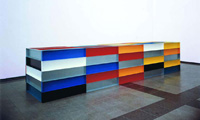 New Presentation of the Museum's Permanent Collection at K 21
New Presentation of the Museum's Permanent Collection at K 21Untitled, 1989. Aluminium, gebogen, verzinkt und farbig gespritzt, Eisen, galvanisiert, [Einbrennlackiertes Aluminium und galvanisiertes Eisen], 150 x 165 x 750 cm, Foto: Walter Klein, Düsseldorf. ©Art Judd Foundation. Licensed by VAGA, NY/VG Bild-Kunst, Bonn 2010.
DUSSELDORF.- The foundation of the Kunstsammlung Nordrhein-Westfalen is an art collection of the highest conceivable quality. Preceding the reinstallation of the collection in July 2010 in an area measuring more than 10,000 m² is a singular presentation in the Ständehaus of K21, one that juxtaposes key works of classical modernism with central positions of contemporary art.
The galleries accommodate a series of highly divergent works, and the results range from the lively dialogue, to the “quarrelsome duet”, to the intimate conversation, but also include small talk, while some encounters may lead to subsequent rendezvous.
Since the presentation at Grabbeplatz has always consisted mainly of paintings, and the one at the Ständehaus primarily of installation, sculptural, photographic, and video works, this exchange also takes place between two and three dimensions.
The outcome is a contest between media: what can painting offer, with its dense surface arrangement, and what is offered by film, which unfolds in temporal succession?
The arrival of the panel paintings, moreover, calls for an altered approach to the architecture of the Ständehaus.
For this presentation of the collection, the building’s arcades will be occupied by “immaterial” art forms: with sound installations that conceptualize the phenomenon of time in various ways.
Silent Revolution, the title of this presentation, was borrowed from a work by Georg Herold, one that engages in dialogue with paintings by Jasper Johns and Georges Braque.
The classical modernism foundation of the Kunstsammlung Nordrhein-Westfalen is featured in the 1st level of Silent Revolution in a series of striking, dialogic juxtapositions.
Belgian artists Marcel Broodthaers and René Magritte joined forces with contrasting interrogations of the museum and of truth; Jeff Wall and Wassily Kandinsky visualize the antagonism between chaos and order; Max Beckmann and William Kentridge draw up résumés of their lives; Paul Klee and Nam June Paik are preoccupied with the universal languages of art and music.
In the second upper story of the Ständehaus, key works of Cubism, Neue Sachlichkeit, and Surrealism provoke commentary in the form of contemporary sculptures by Thomas Schütte, Katharina Fritsch, Paloma Varga Weisz, and others.
One such juxtaposition is that between Beckmann’s brutally dispassionate depiction of murder in “Die Nacht” (The Night) and Thomas Hirschhorn’s model of a two-family house, which exemplifies the kind of involuntary proximity of contrary attitudes.
In the 3rd upper story are works by Piet Mondrian, Marcel Duchamp, Otto Dix, Kurt Schwitters, Gerhard Richter, and Francis Bacon.
Here, our circuit finds its preliminary terminus in a room containing black pictures – before the dialogic principle continues in the light-flooded dome space. More than 30 three-dimensional works have been assembled to form a densely configured sculpture garden – installed with assistance from Düsseldorf artist Markus Karstieß – where viewers are invited to stroll and linger.
Pablo Picasso’s bronze head of “Fernande” encounters John Chamberlain’s painted sculpture, while works in plaster by Max Ernst mingle with recent artistic positions, including loans designed to complement the collection in striking ways.
 New Presentation of the Museum's Permanent Collection at K 21
New Presentation of the Museum's Permanent Collection at K 21